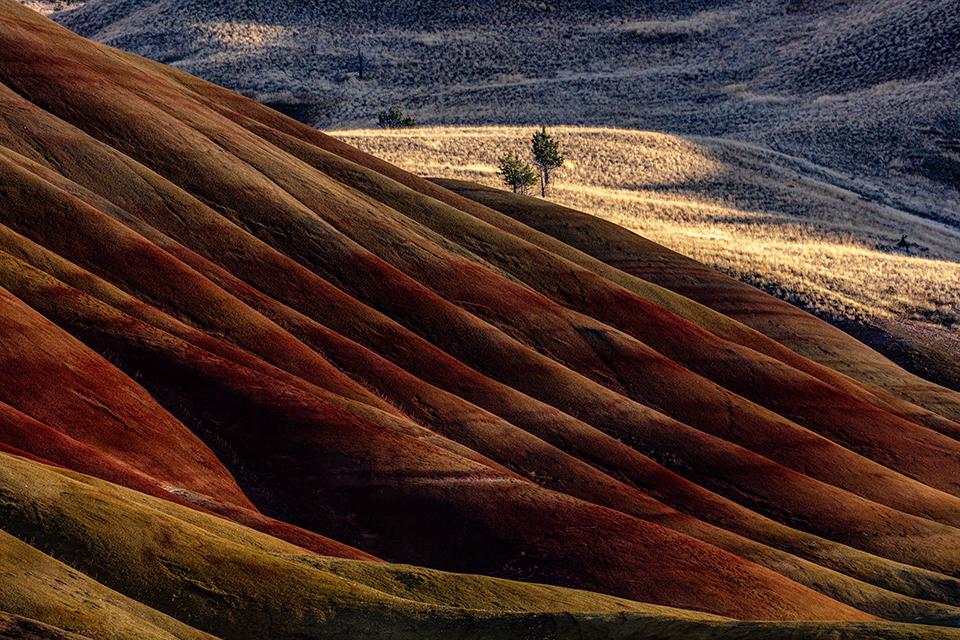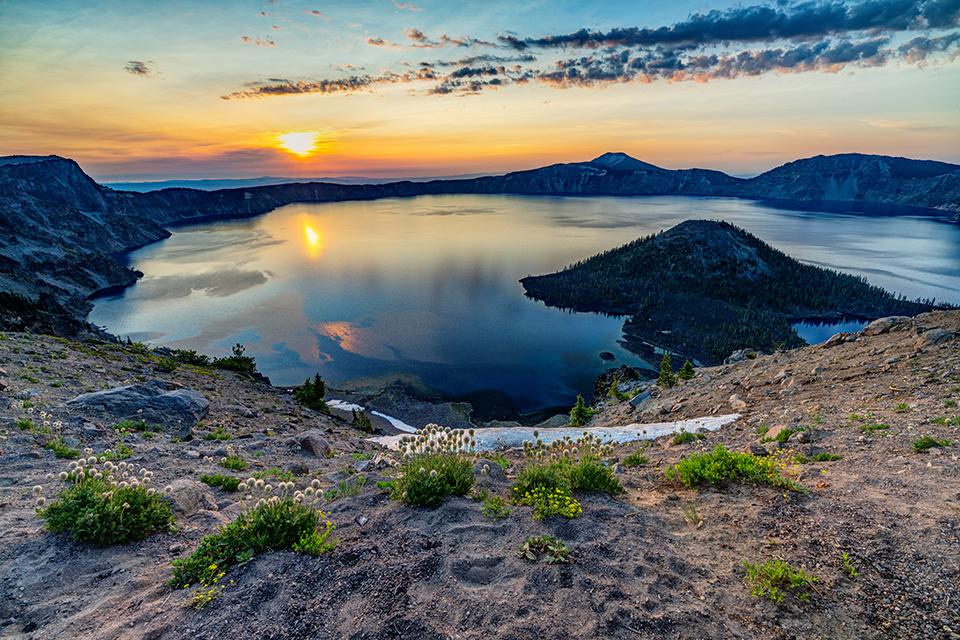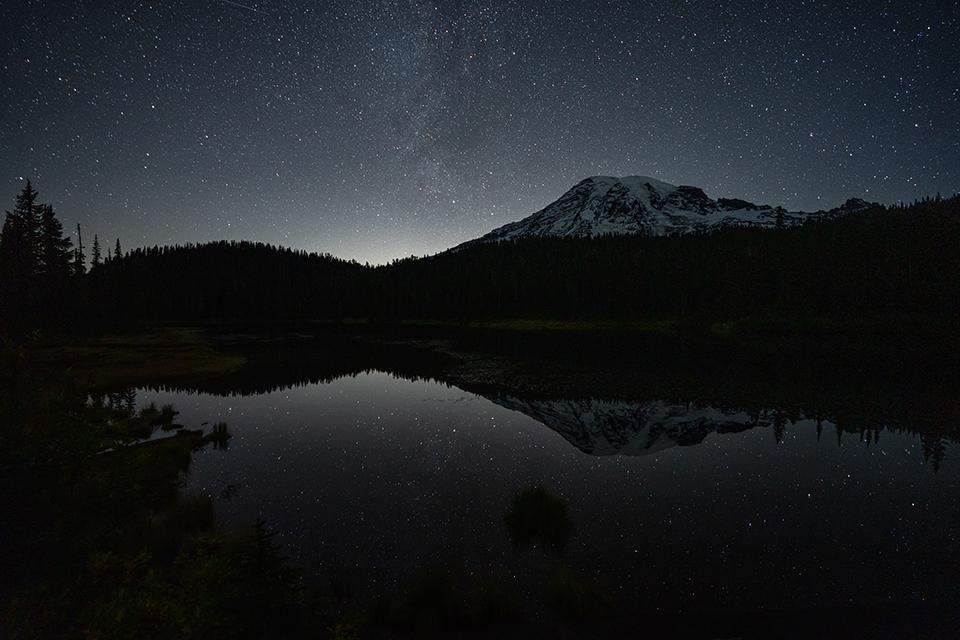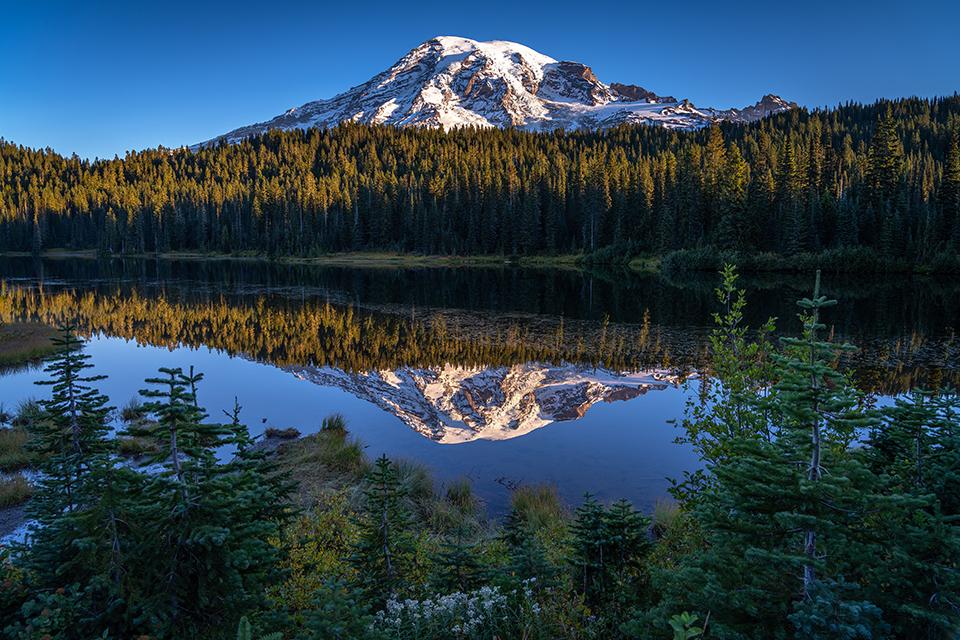
Late afternoon in the Painted Hills Unit, John Day Fossil Beds National Monument / Rebecca Latson
Happy New Year! Ok, maybe more like Happy New Year?
I’m continuing with a tradition I started a few years ago with the Traveler, in which I choose anywhere from 7 to 10 of my favorite photos from the previous year, explaining not only why I like each shot, but how I captured the composition. Last year, I traveled to John Day Fossil Beds National Monument, Mount Rainier National Park, Crater Lake National Park, Redwood National and State Parks, and Whiskeytown National Recreation Area.
As usual, I had a bit of a time whittling the images down to just 10. It’s a thing with photographers, I guess. We like all of our stuff so picking out just a few can be downright difficult. Originally, I tried to choose two favorite images from each trip, but I found I preferred more than two from a specific park, so I ultimately just went with the photos I liked the best, regardless of location. These images are listed in no particular order.
1. Late Afternoon in The Painted Hills Unit, John Day Fossil Beds National Monument (Oregon)
There are three units within this national monument. My favorite (and probably the favorite of most visitors) is the Painted Hills Unit. You can see why. The maroon and greenish-yellow stratigraphic layers, indicative of climate changes occurring millions of years ago, become vibrantly lush when the sunlight hits them at just the right angle. And, because the sun was at an angle to the view, I used my circular polarizing lens (CPL) to bring out the color and texture of the landscape.
2. Folds of Velvet, John Day Fossil Beds National Monument (Oregon)

Folds of velvet, John Day Fossil Beds National Monument / Rebecca Latson
As I was driving out of the Painted Hills Unit, I decided I wanted a few more images of these gorgeous lushly-colored hills. I used my 100-400mm telephoto because I wanted a close-up focus on three things: those sensuous folds of hillside, the two trees on the stubby, pale yellow grass, and the velvety texture of the deep maroon color. The effect would not have been the same had I chosen a more wide-angle view of the scene.
3. Burls at the Base, Prairie Creek Redwoods State Park, Redwood National and State Parks (California)

Burls at the base, Prairie Creek Redwoods State Park, Redwood National and State Park / Rebecca Latson
I wrote an article about how these skyscraper coastal redwood trees were made for vertical shots. Of all the verticals I captured, this one is my favorite. I used my 11-24mm ultra-wide lens to capture the entire tree and give it a sort of funky perspective, highlighting the base of the tree, with its burls. Ultra-wide-angle lenses are great for capturing the entire scene while providing interesting perspectives when moved up or down.
4. Serene Sailing Under A Smoky Sky, Whiskeytown National Recreation Area (California)

Serene sailing under a smoky sky, Whiskeytown National Recreation Area / Rebecca Latson
On assignment for the Traveler, I visited this national recreation area eight miles west of Redding. Wildfires raged all over the state and the ensuing smoke filtered into my compositions. There’s an overall theme of “pyramids” to the composition, from the smoke-softened mountain peaks, down to the shape of the sailboat, then down to the shape of the shrubbery in the foreground. Despite the veil of wildfire smoke, the scene still looked serene.
5. Sunrise from the Watchman Overlook, Crater Lake National Park (Oregon)

Sunrise from the Watchman Overlook, Crater Lake National Park / Rebecca Latson
Online research and studying the park map allowed me to figure out where I might find great locations around Crater Lake for sunrise and sunset compositions. My first sunrise there was viewed from Watchman overlook. At first, I didn’t think the sunrise would amount to anything, with hazy clouds in the sky. But after the official sunrise time passed, I heard another photographer standing away from me exclaim “Oh, look!” Rising through and then above the haze was a bright ball of sunshine, which reflected in the lake and created a little backlight against the white tufts of pasqueflowers in the foreground. I used another wide-angle lens, the 16-35mm to capture as much as possible of the lake. I chose not to use any ultra-wide-angle lens because I wanted to use a CPL filter in addition to my grad ND filter, which I held flush against the lens to prevent overexposure of the sky. Ultra-wide lenses have bulbous fronts which are not conducive to screwing filters on the front. Instead, these lenses have a slot in the back for a special CPL to be slipped into.
6. Comet NEOWISE Over Crater Lake, Crater Lake National Park (Oregon)

Comet NEOWISE over Crater Lake, Crater Lake National Park / Rebecca Latson
I’ve only witnessed one other comet in my life, and that was decades ago when comet Hale-Bopp swished past earth. Upon the realization I’d be at Crater Lake during the same time as NEOWISE was flying past, I knew I needed to try and capture an image of both lake and comet. I like this image not because of any photographic artistry, but because of the remembered feeling of standing there in the cold darkness, watching the clear sky light up with pinpoints of bright stars, the Milky Way behind my back (and out of the composition), and that one bright ball of light with the wispy, satiny long tail. I felt super lucky to have not only witnessed this celestial event with my own eyes, but to have captured it on digital “film”, as well.
This shot required a long shutter speed and manual focus. Auto focus would not have worked at all, because there was nothing bright enough for the auto focus to work with. Slow shutter speeds allow what little light there is from the stars and anything else to show up in the composition. A tripod was an absolute must, to prevent camera shake blur and I also used the camera’s 2-second timer so that any vibration from pressing the shutter button would dissipate. Note: a corded or wireless remote shutter release would have also worked for the night shots.
7. A Smoky Morning in the Park, Mount Rainier National Park (Washington)

A smoky morning in the park, Mount Rainier National Park / Rebecca Latson
I was working on a story for the Traveler about wildfire smoke from other places and how it might affect nearby national parks. My first stop upon arrival in the park was at Reflection Lakes, a new favorite of mine for star and sunrise imagery. As I walked around one of the smaller lakes, I decided to set down my tripod and capture a view of the smoke-veiled globe of sun between the trees. A grazing doe stepped into the shot, not minding my presence. That wildlife entry gave the otherwise hazy, matte-like landscape a little bit of added character.
8. The View from Glacier Overlook, Sunrise Area, Mount Rainier National Park (Washington)

The view from Glacier Overlook, Sunrise area, Mount Rainier National Park / Rebecca Latson
In all the times I’ve visited the Sunrise area of this national park, I’ve never really done many long hikes there. Ok, a long hike to me is more than 3 miles. On this occasion, I ultimately hiked a little over 5 miles, along a loop that took me from Emmons Vista to Sunrise Camp to a spot called Glacier Overlook, before continuing on toward the First Burroughs, then Frozen Lake, then eventually back to the Sunrise parking lot.
I needed a short break after huffing and puffing up the trail from Sunrise Camp to Glacier Overlook, and this vista, with all those lovely saturated colors on that crystal-clear day, beckoned me to capture the view. My CPL filter removed some of the glare and haze and made those colors pop even more.
9. Pre-Dawn Stars and "The Mountain" at Reflection Lakes, Mount Rainier National Park (Washington)

Pre-dawn stars and "The Mountain" at Reflection Lakes, Mount Rainier National Park / Rebecca Latson
As I mentioned with image #7, Reflection Lakes is a great place for night and sunrise photography. When I’d arrived there previously, with image #7, night photography and sunrise photography were muted, due to the influx of wildfire smoke. So I made it a mission to return on a much clearer day (according to weather reports) to attempt more star and sunrise shots at this spot. I couldn’t have asked for better than what is in that composition. The sky was clear, the water was mirror-smooth, and despite that glow of some town beyond, the stars sparkled and reflected over mountain and lake.
As with the comet NEOWISE image #6, I used a slow shutter speed and manual focus with the camera on a tripod and a 2-second delay to the shutter click. If you are like me, you might have problems trying to manual focus clearly on an object – my eyesight isn’t quite what it used to be, hence bifocals. Even if you are setting your lens to focus on infinity. You see, different lenses, even the same brand, focus on a different portion of that infinity mark (the sideways figure-eight). What I learned to do was use auto focus to zone in on a distant object during the daytime, look to see where the infinity mark is, and take a smartphone pic of that spot so I have a reference to look at when I attempt manual focus at night.
10. “The Calendar Shot”, Mount Rainier National Park (Washington)

"The Calendar Shot," Mount Rainier National Park / Rebecca Latson
While I stood at a different spot at Reflection Lakes, a small, organized photo tour came through. I overheard one photographer say to another photographer “Now, there’s your calendar shot!” I didn’t really think much about it until I was toting my tripod and pack back toward the car. I looked over and saw this gorgeous apre-sunrise view. I knew then that this was my calendar shot, too.
I did use a CPL filter for this image. I rotated the outer filter ring just enough to deepen the colors of the composition without removing the reflection.
There you have it. My 10 faves from 2020. I managed to salvage a little bit of beauty from what could otherwise be considered not one of the best years ever experienced by anybody. I sure hope 2021 looks up for all of us, and that you are able to get out and about to photograph your own national park faves. Some of the views here, you may already have visited yourself, and they may already be favorites of yours. Or, they may be new favorites for you to capture with whatever camera you have.



Comments
Good work, Rebecca. You had a good year of photography in spite of the pandemic.
Wonderful pictures. I am going to send a link to them to all my friends. Thank you!
Amazing photos, as always!
Wonderful shots, as usual, Rebecca. Thanks much.